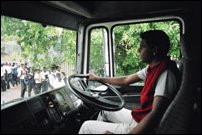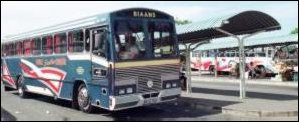Management of Fatigue in Road Transport
(Extracts from recommendations made at the Second
International Conference on Fatigue in Transportation at Fremantle in
Western Australia - 1996)
 MOVES to get the government, the transport industry and the community
involved in finding solutions to the problem of driver fatigue were
discussed over two days at the conference. Delegates agreed that driver
fatigue arose not only from the number of hours spent at the wheel, but also
from other causes. Limiting driving hours did not address all the problems.
Effective fatigue management called for a close examination of all the
causes. MOVES to get the government, the transport industry and the community
involved in finding solutions to the problem of driver fatigue were
discussed over two days at the conference. Delegates agreed that driver
fatigue arose not only from the number of hours spent at the wheel, but also
from other causes. Limiting driving hours did not address all the problems.
Effective fatigue management called for a close examination of all the
causes.
It was accepted that at present there was no single, unequivocal, direct
measurement of fatigue by which affected drivers may be identified. It was
hoped that future research would provide answers. However, it was agreed
that self-assessment for fatigue needed to be encouraged. At present this
was the only way to detect fatigue. Research indicated that most drivers
were aware of their likelihood of falling asleep, but failed to appreciate
the imminence of actually doing so at the wheel.
It was less clear to what extent drivers were aware of their own decline
in vigilance during long driving spells. Pro-longed driving might therefore
lead to impaired performance such as lengthened reaction times and increased
risk taking, long before nodding off occurred. For self-assessment to be
effective, the education of drivers and the industry, about the warning
signs of declining vigilance and drowsiness, needed to be done. A start had
been made in the United States and Australia. However, much remained to be
done to inform drivers about the causes and dangers of declining vigilance
and drowsiness. There was an important public health role for governments in
providing education. driving spells. Pro-longed driving might therefore
lead to impaired performance such as lengthened reaction times and increased
risk taking, long before nodding off occurred. For self-assessment to be
effective, the education of drivers and the industry, about the warning
signs of declining vigilance and drowsiness, needed to be done. A start had
been made in the United States and Australia. However, much remained to be
done to inform drivers about the causes and dangers of declining vigilance
and drowsiness. There was an important public health role for governments in
providing education.
Among the recommendations was the fact that governments had four areas of
responsibility. They were:
- The promotion of research into fatigue, and potential solutions.
However, it was noted that industry involvement in research was also
desirable because of the need to collect data, not only from drivers
engaged in haulage operations, but also to improve industry practices.
- The implementation of education programmes about fatigue for the
driver, the industry and the community. For drivers, information on
reducing their exposure to fatigue was important. This would involve
media dissemination of information on the causes of fatigue, signs of
declining vigilance and onset of drowsiness, and the most appropriate
countermeasures to fatigue. Health related information also needed to
focus on drugs. It was a fact that stimulant drug use was widespread in
the road transport industry as a solution to the sometime unrealistic
demands of delivery schedules. Because this was not recognised as a
health problem, no information was available on the drugs' effects and
the costs to drivers' health. This information was vital to the industry
if drug related harm was to be minimised.
- Governments had ultimate responsibility for road transport
infrastructure. The cost effectiveness of several fatigue
countermeasures such as rumble strips, painted edge lining and
sufficient rest areas needed to be investigated and implemented where
possible. Improving the quality of the road transport system to better
cope with the increasing fleet of light and heavy vehicles, was a high
priority for road safety.
- Governments had a key role in implementing cost-effective road-based
countermeasures to fatigue. They needed to bring together stakeholders
in road transport to facilitate appropriate legislation to limit
fatigue. Limiting driving hours might not be the most cost effective
solution to controlling fatigue, although it might be the most practical
strategy to ensure that drivers had adequate time for continual sleep
during each 24-hour period. However, it was difficult to enforce, and
undue emphasis on regulating driving hours, might distract from
alternative strategies such as the development of industry based fatigue
management systems.
- There was a need for appropriate legislation that could be
enforceable. The legislation must produce an expectation that breaches
would be prosecuted at all levels of the organisation and not restricted
to drivers. Non-compliance must not produce the expectation of
commercial gain. An appropriate framework to control fatigue was the
occupational health and safety legislation. The development of an
industry-wide fatigue management plan was considered an appropriate
mechanism to regulate fatigue.
The industry on the other hand had a duty to care for its workers and
should provide a safe work environment as provided for in the occupational
health and safety legislation. This included setting reasonable trip
schedules, regulating the driving and working hours, providing adequate
arrangements for rest and recovery at the depot and elsewhere. It also
needed to provide appropriate education on fatigue and other occupational
health matters such as drug use and should participate in the development of
industry-wide fatigue management programmes as part of its self-regulation.
The industry also had a responsibility to the community to provide not
only a productive service but also a safe one. The community expectation was
that merchandise and produce would be delivered in a timely and safe manner.
To meet these expectations, the industry must self regulate effectively by
adopting fatigue management plans that were open to public audit. It should
accept that regulation must take place at all levels of the organisation,
and that not only the driver but also the organisation were responsible for
the effective operation of a safe management plan.
The community also should engage in education programmes at all levels on
the causes and countermeasures to fatigue. The costs and benefits of
introducing safer work practices to better manage fatigue in the industry
should be debated widely.

Related Topic
Sleeping and Driving Don't Mix

 back back
|
 MOVES to get the government, the transport industry and the community
involved in finding solutions to the problem of driver fatigue were
discussed over two days at the conference. Delegates agreed that driver
fatigue arose not only from the number of hours spent at the wheel, but also
from other causes. Limiting driving hours did not address all the problems.
Effective fatigue management called for a close examination of all the
causes.
MOVES to get the government, the transport industry and the community
involved in finding solutions to the problem of driver fatigue were
discussed over two days at the conference. Delegates agreed that driver
fatigue arose not only from the number of hours spent at the wheel, but also
from other causes. Limiting driving hours did not address all the problems.
Effective fatigue management called for a close examination of all the
causes.  driving spells. Pro-longed driving might therefore
lead to impaired performance such as lengthened reaction times and increased
risk taking, long before nodding off occurred. For self-assessment to be
effective, the education of drivers and the industry, about the warning
signs of declining vigilance and drowsiness, needed to be done. A start had
been made in the United States and Australia. However, much remained to be
done to inform drivers about the causes and dangers of declining vigilance
and drowsiness. There was an important public health role for governments in
providing education.
driving spells. Pro-longed driving might therefore
lead to impaired performance such as lengthened reaction times and increased
risk taking, long before nodding off occurred. For self-assessment to be
effective, the education of drivers and the industry, about the warning
signs of declining vigilance and drowsiness, needed to be done. A start had
been made in the United States and Australia. However, much remained to be
done to inform drivers about the causes and dangers of declining vigilance
and drowsiness. There was an important public health role for governments in
providing education.